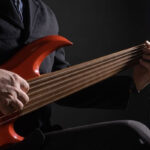Many guitarists, even experienced ones, might be stringing their guitars incorrectly without realizing the potential damage it can cause. When I started at lutherie school, I discovered I was among them. Inspecting guitars in my shop, I’ve seen firsthand how common this issue is. You might think, “I’ve been stringing guitars for years, and they’ve been fine!” I used to think the same way, until I understood the harm incorrect stringing inflicts on a guitar’s bridge plate.
This small, but crucial piece of rosewood or maple sits inside your guitar, directly beneath the bridge. It’s the anchor point for the ball ends of the strings, preventing them from ripping through the softer spruce top under tension. Correctly stringing a guitar is simple and essential. Neglecting this can lead to premature wear of the bridge plate holes, eventually requiring costly and preventable repairs.
The key to proper Guitar Stringing is ensuring the string ball ends are parallel to the guitar body and firmly seated against the bridge plate before tensioning. Using bridge pins to force ball ends into place and then pulling the string to seat them is a damaging technique. This action turns the string windings into a miniature saw, carving grooves into the bridge plate with each string change. Allowing ball ends to sit perpendicular to the body is equally harmful. If you notice string windings protruding excessively from the bridge towards the saddle, it’s a telltale sign of bridge plate wear requiring repair to prevent further damage. Fortunately, following the simple steps outlined below will keep your bridge plate in pristine condition for decades.
For a detailed visual guide, I recommend checking out my video on correct string installation, part of the Setup and Repair Series at Robbie O’Brien’s Lutherie Academy. Follow this link to explore my class and other valuable topics.
Also, take a look at this quick video demonstrating an efficient method for stringing the tuning posts on the peghead:
Show as slideshow
By adopting proper stringing techniques, you ensure your guitar remains in top condition, avoiding unnecessary bridge plate repairs and maintaining its longevity for years to come.

